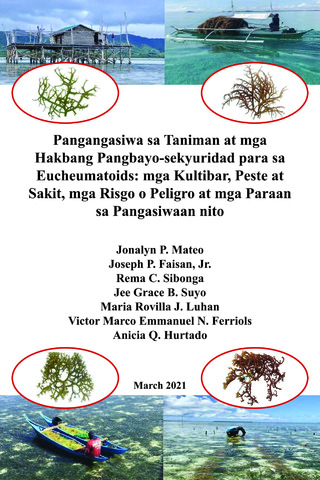Clonal production of Kappaphycus alvarezii (Doty) Doty in vitro
- Global styles
- MLA
- Vancouver
- Elsevier - Harvard
- APA
- Help

閲覧/開く
日付
2017Page views
900ASFA keyword
AGROVOC keyword
Taxonomic term
Metadata
アイテムの詳細レコードを表示するCited times in Scopus
- Citations
- CrossRef - Citation Indexes: 15
- Scopus - Citation Indexes: 18
- Captures
- Mendeley - Readers: 48
Share
抄録
Micropropagation has proven to be a reliable method to mass produce certain crops. This method also has been applied in macroalgae to produce clones for seaweed farming. Protocols for callus production and shoot regeneration from protoplasts have been established for some seaweed species like Kappaphycus alvarezii. Cells and larger tissues, whether in solid or suspension medium, have been used to propagate clones which were later tested for suitability for farming. Although clonal production was successful, the long duration of culture in vitro limits the production process making the growing of Kappaphycus in vitro an expensive technique to produce clones. In this study, K. alvarezii was grown in vitro to develop a more efficient protocol for the production of clones. Small sections of Kappaphycus were grown in suspension for 1 month under the same temperature, light, and salinity. The type of media, source of explants, length of explants, and stocking density that resulted in the highest growth rate and survival rate were determined. Growth rate of K. alvarezii is significantly higher in media with inorganic nitrogen added than in Grund medium or Ascophyllum nodosum medium only. The appearance of shoot primordia as early as 5 days was observed in media with higher nitrogen concentration. Growth rates of explants approximately 3 and 5 mm are significantly higher than 10 mm sections. Shoots develop significantly faster in explants from tips than sections from older branches. Growth rate of K. alvarezii grown at 0.5, 0.75, 1, 1.25 s 10 mL−1 of medium is not significantly different. This protocol could significantly reduce the (1) time of culture and (2) cost of plantlets production by not using plant growth regulators and formulated media in vitro. Nursery reared plantlets/propagules for farming would be affordable to the stakeholders for sustainability of seaweed production.
Suggested Citation
Luhan, M. R. J., & Mateo, J. P. (2017). Clonal production of Kappaphycus alvarezii (Doty) Doty in vitro. Journal of Applied Phycology , 29, 2339-2344. https://doi.org/10.1007/s10811-017-1105-7
Type
ArticleISSN
0921-8971; 1573-5176Collections
- Journal Articles [1247]
Related items
Showing items related by title, author, creator and subject.
-
Characterization of wild eucheumatoids from Visayas, Philippines as inferred from the mitochondrial cox2-3 spacer sequence
Sibonga, Rema ; Brakel, Janina
; Brakel, Janina  ; Gachon, Claire
; Gachon, Claire  ; Faisan, Joseph P., Jr.
; Faisan, Joseph P., Jr.  ; Brodie, Juliet
; Brodie, Juliet  ; Ward, Georgia
; Ward, Georgia  ; Ferriols, Victor Marco Emmanuel
; Ferriols, Victor Marco Emmanuel  ; Luhan, Maria Rovilla
; Luhan, Maria Rovilla  ; Hurtado, Anicia Q. (University of the Philippines Visayas, 2022)
Eucheumatoids are the major seaweed species cultivated in most coastal areas in the Philippines, being a major source of income for many families. Seaweed farmers face issues such as lack of good quality cultivars and the ...
; Hurtado, Anicia Q. (University of the Philippines Visayas, 2022)
Eucheumatoids are the major seaweed species cultivated in most coastal areas in the Philippines, being a major source of income for many families. Seaweed farmers face issues such as lack of good quality cultivars and the ... -
Biyah diin in pagparagan sin pagtanuman agal agal iban pag'ayad ha pag' urulan sin kabuhi: Binhi atawa tanumun agal agal, manga mangangaun iban kumakangii' iban sakit, manga anib atawa makamula' iban biyah diin in pagpahilunnah sin anib atawa piligru ha pagtanum agal agal
In buwk-buwk pahati ini nahinang iban kiyasulat paglabay upat tahun ha pagsaliksik ha pag’usaha agal agal ha Pilipinas hinang sin tumpukan sin GlobalSeaweedSTAR Philippine ha bitsara kahatihan sin kamatauran. Makatagama ... -
Pangangasiwa sa taniman at mga hakbang pangbayo-sekyuridad para sa Eucheumatoids: Mga kultibar, peste at sakit, mga risgo o peligro at mga paraan sa pangasiwaan nito
Ang polyeto na ito ay inihanda at isinulat ng GlobalSeaweedSTAR Philippine Team sa payak na lengwahe matapos ang apat na taong pananaliksik sa industriya ng pag-aalaga ng mga halamang-dagat sa Pilipinas. Nais nito na ...






